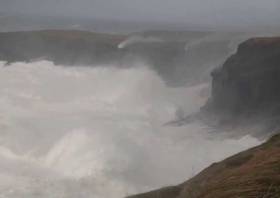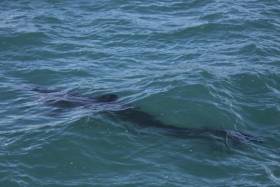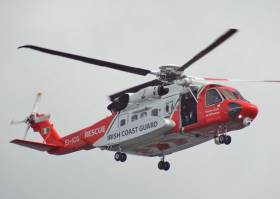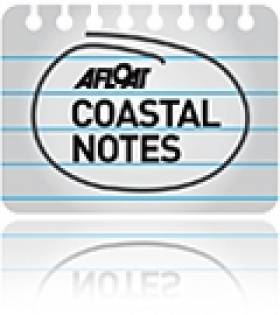Displaying items by tag: Clare
County Clare is a place unto itself and a magic if challenging coastline for boats, bounded as it is by the Atlantic to the west, Galway Bay to the north, Galway County to the northeast, Lough Derg and the Shannon to the east and southeast, and the entire length of the mighty Shannon Estuary to the south.
For the casual observer, it looks on the map as though Clare should naturally be in Connacht, as it’s all west of the Shannon. But it’s in Munster. So the The Banner County of hurling and music fame first asserts itself as somewhere special in its own right regardless of either Province, reinforced by being the only county with what are unmistakably border posts - informal maybe, but very real frontier markers nevertheless.
 The county of many coasts – if anything, Clare first thinks of itself as being somewhere uniquely special before going along with its unexpected location in Munster rather than Connacht. Image courtesy Clare County Library
The county of many coasts – if anything, Clare first thinks of itself as being somewhere uniquely special before going along with its unexpected location in Munster rather than Connacht. Image courtesy Clare County Library
INFORMAL BUT REAL BORDER POSTS
We noticed one such border post as we were leaving Clare, in a service station at Kinvara while heading into County Galway. It’s a notice that speaks for itself.
 County Clare Border Post window notice, seen near Kinvara. Photo: W M Nixon
County Clare Border Post window notice, seen near Kinvara. Photo: W M Nixon
INDOOR VENUES FOR OUTDOOR SPORT
It reminded me of just how powerful an attraction an indoor setting - or even a domestic venue - can be to demonstrate heartily outdoor sport. Way back in the day, as in pre-history, the late night select group’s mid-week conversation in the back bar of the Royal Ulster Yacht Club in Bangor on Belfast Lough got around to kitchen modernisation, and our father foolishly mentioned that we’d had the up-date done on the kitchen in our substantial but rather weird family house at the east end of Ballyholme Bay.
 Just the place for late-night discussions about domestic kitchen modernisation. The 1899-built Royal Ulster YC clubhouse in Bangor was designed by Vincent Craig, younger brother of political leader James Craig. He also designed the W B Yeats Centre in Sligo, originally as the now-defunct Belfast Banking Company’s flagship premises in the northwest. Photo: RUYC
Just the place for late-night discussions about domestic kitchen modernisation. The 1899-built Royal Ulster YC clubhouse in Bangor was designed by Vincent Craig, younger brother of political leader James Craig. He also designed the W B Yeats Centre in Sligo, originally as the now-defunct Belfast Banking Company’s flagship premises in the northwest. Photo: RUYC
So when the patient steward Willie Moran finally declared the place closed, with the final hour or so of imbibing simply registered as “Sundries” on everyone’s slates, nothing would do the group but a small hours visit to the house to assess the quality of the kitchen update. And along with them came a recently-joined member, Colonel Blair Mayne, normally a shy well-behaved person, but increasingly less so as the nights went on.
INITIALLY WELL-BEHAVED
Glasses in hand down at the house, they all behaved properly in approving the kitchen. But then the holy father made the mistake of mentioning that the smart new polycarbonate glass water jug was unbreakable.
 Blair Mayne at the peak of his time playing international rugby for Ireland in the late 1930s. Photo: IRFU
Blair Mayne at the peak of his time playing international rugby for Ireland in the late 1930s. Photo: IRFU
“We’ll see about that” says Blair Mayne, and before anyone could stop him, he demonstrated his rugby talent with a neatly executed drop kick of the jug across the kitchen, aimed at a cupboard whose outline vaguely resembled a miniature set of rugby posts.
The fancy jug did stay intact, and the kick was beautifully executed in a general sort of way. But it lacked precision in direction. Instead of landing as a goal between the imaginary posts on the cupboard door, it landed a few inches to the left into the long open shelf with all the ordinary glassware and the family’s cherished collection of Waterford cut crystal. It exploded.
THOSE NASTY CRYSTAL CUBES
Quite how they managed to get Colonel Mayne out of the place we’ve now no idea, as he could become an unstoppable force. But as kids we’d slept through it all, yet when we came down in the morning for breakfast before school, the mood was not good, with the home helps grimly sweeping up bits of glass.
You know how it is with crystal. It break into nasty little glass cubes, and they can hide away for ever. So for weeks we’d to be careful it hadn’t got into the food. But meanwhile the morning mood was seriously tense, and from the dining room next we could hear a very grown-up sort of conversation reaching a conclusion:
NOISES OFF
“I don’t care if he is a war hero. That Man is never coming back in my house again”.
Our saintly mother seldom raised her voice, indeed she never raised it all, but instead when annoyed she spoke extra-firmly in very clearly enunciated and unmistakable terms. So from then on, not only did Colonel Mayne of the SAS and North African Desert and Italian peninsula war excesses and heroics never darken our door again in his few years left on the planet, but for long childhood years I knew nothing whatever about this flawed local legend.
It was only when we started cruising in 1960 as a group of under-age seafarers on the cheekily-chartered 9-tonner Ainmara (our deep voices on the phone had fooled the owner into assuming we were adults) that I learned from a shipmate about someone I’d only known of - and very seldom – as That Man.
 The “cheekily-chartered” Ainmara on a later charter cruise to West Cork in 1966, when - in early June - she was the only yacht in Glandore. For the first charter to Scotland in 1960, the owner had to make the best of things when the some of the misleadingly deep-voiced chartering crew turned up in short trousers. Photo: W M Nixon
The “cheekily-chartered” Ainmara on a later charter cruise to West Cork in 1966, when - in early June - she was the only yacht in Glandore. For the first charter to Scotland in 1960, the owner had to make the best of things when the some of the misleadingly deep-voiced chartering crew turned up in short trousers. Photo: W M Nixon
For the shipmate’s father had been a hard case of similar size and outlook as his pal Blair Mayne, and it was a revelation hearing - in the neutral territory of some remote Scottish loch - about that Dynamic Duo’s exploits through North Down, and finally making sense of vague memories of The Drop Kick In The New Kitchen.
THERE’S SOMETHING IN THE CLARE AIR
That we should have ended up here, so far from discussing Clare’s fascination, is altogether typical of the effect of place. But some people just don’t get County Clare. It may be because the county seems oversold after they’ve done the contemporary tourists’ (there’s no way they’re travellers) ruthlessly hurried box-tick modern trip to Clare such that - in one day with a fast-moving bus and a rigid schedule – they can think they’ve seen see off the lot.
For in one day (having departed Dublin before dawn) they anticipate a glimpse of the Shannon Estuary, a whirl around Kilrush Harbour Marina and Boatyard, a notion of the Vandeleur Gardens, a nod to Loop Head and a blast of Kilkee, a sense of The Burren, a whiff of Lahinch Golf Course, a taste of Liscannor stone, the shortest possible visit to the Aran Islands from crazy Doolin with restoration of sanity in peaceful and uber-pretty Ballyvaughan, and then take in Seamus Heaney’s Flaggy Shore while belting along for the first County Galway stop at Kinvara (or Kinvarra), and all which that evocative name implies for traditional boat sailors - people who, of course, wouldn’t dream of trying to see the best of Clare in anything less than a week, whatever the type of transport used.
 Traditional boats from Connemara in Kinvara, where they appreciate that when God made time, he made a lot of it, and visiting Clare should be done in an appropriately leisurely manner rather than some modern groups’ whistle-stop single-day chases. Photo: CnmB
Traditional boats from Connemara in Kinvara, where they appreciate that when God made time, he made a lot of it, and visiting Clare should be done in an appropriately leisurely manner rather than some modern groups’ whistle-stop single-day chases. Photo: CnmB
BEST OF INTENTIONS FOR DETAILED EXPLORATION
For sure, when cruising round Ireland you may well have intended to go deep inland, through river-mouths and natural harbours, in Clare as elsewhere. Certainly they will have looked intriguing and inviting on paper or screen in winter, when making the cruise plans around the reassuring comfort of the kitchen table while the dark and stormy night howls outside.
“ISLANDS ONLY” GOING ROUND IRELAND
But in a dozen or so times sailing around this very special and sensibly-sized place at the heart of everything called Ireland, it has emerged that if the summer weather is at all reasonable, we’ve tended to stick to the island anchorages, and a couple of times have made cruising circuits with only one or two mainland contacts.
 The Call of the Isles. Inishbofin is one of the best when island-hopping round Ireland. Like many of the islands, the sun can be shining over this lower land offshore, when (as seen here) the clouds can be seen gathering above the Twelve Bens oshore in Connemara. Photo: Inishbofin Dev Co.
The Call of the Isles. Inishbofin is one of the best when island-hopping round Ireland. Like many of the islands, the sun can be shining over this lower land offshore, when (as seen here) the clouds can be seen gathering above the Twelve Bens oshore in Connemara. Photo: Inishbofin Dev Co.
We’re outdone by a noted cruising skipper of times past who had made his large boat so comfortable - whether anchored or sailing - that he made a round Ireland cruise in which only his crew went ashore in more than a dozen anchorages, while he stayed happily on board throughout.
 Kilrush Marina in its early days. Since this photo was taken, the gap between town, harbour and sea has seen building development and restoration to give a great sense of connected community, and post-pandemic the town has found new vitality with increased hospitality options and the creation of full restaurant facilities at the nationally-renowned Vandeleur Gardens. Photo: kilrush.ie
Kilrush Marina in its early days. Since this photo was taken, the gap between town, harbour and sea has seen building development and restoration to give a great sense of connected community, and post-pandemic the town has found new vitality with increased hospitality options and the creation of full restaurant facilities at the nationally-renowned Vandeleur Gardens. Photo: kilrush.ie
INLAND EXPLORATION
But if you’re holed up in bad weather in somewhere secure like Kilrush, it used to make sense to hire a car for a couple of days (when car hire fees were reasonable) to enable the crew to see off the high stool days in some inland spots, while finding inter alia that the two main dinghy racing clubs in Clare don’t bother with the sea at all – they race on lakes either at Cullaun SC at Kilkishen, or Killaloe SC on Lough Derg, where club now isn’t quite at Killaloe, it’s up the road a step or two at the marvellously-named Ogonnelloe, but never mind.
 Being County Clare, Killaloe Sailing Club is actually located at Ogonnelloe, but that gives direct access to the open waters of Lough Derg
Being County Clare, Killaloe Sailing Club is actually located at Ogonnelloe, but that gives direct access to the open waters of Lough Derg
STEVE MORRIS’S WONDERFUL WORK AT KILRUSH
So although any sailing person’s land-travelling Clare visit is obviously built around Kilrush and particularly the marvellous work that Steve Morris and his team are doing there in the boatyard, the continuing national references to Clare as The Banner County of legendary hurling performances start to take root once you’re inland at all, and we had unavoidable reminders recently while entering and leaving on a land cruise.
 Steve Morris (on ground) and James Madigan this month in Kilrush with the latest miracle of Kilrush Boatyard’s restoration of the 1903 Dublin Bay 21ft Class for the DB21 Association inspired by Hal Sisk and Fionn de Barra
Steve Morris (on ground) and James Madigan this month in Kilrush with the latest miracle of Kilrush Boatyard’s restoration of the 1903 Dublin Bay 21ft Class for the DB21 Association inspired by Hal Sisk and Fionn de Barra
MARTY THE MAIN MAN
Initially while heading deeper into the county, we found ourselves topping-up the car’s fuel immediately west of Ennis with the promise of the real Clare in prospect, and the same was being done for the next car along by its driver, Marty Morrissey. He really does look just like Marty Morrissey, which you might well have thought impossible.
Fortunately I was too busy watching the fuel dial to get involved with the cheerful chat that enveloped everyone else the forecourt, otherwise I might have asked why - of all the excellent multi-service facilities in the western approaches of Ennis - the voice of GAA sport had chosen the outlet that real oldies might have described as the Protestant service station.
CLARE A PLACE OF MEMORY AND DREAMS
But then Clare is a place where everything seems possible, a place of memory, dreams and fantasy After all, when you mark your arrival in the county with dinner at Dromoland Castle, it’s a setting which sometimes seems like Disneyland on speed, yet it really was the birthplace of 1923-1925 circumnavigator Conor O Brien of Saoirse’s father, who in turn was the son of Young Irelander William Smith O’Brien.
 Disneyland on speed….Dromoland Castle in County Clare was still the ancestral home of the O’Briens of Thomond and Inchiquin when Conor O’Brien of Saoirse fame’s father was born there. Photo: Dromoland Castle Hotel
Disneyland on speed….Dromoland Castle in County Clare was still the ancestral home of the O’Briens of Thomond and Inchiquin when Conor O’Brien of Saoirse fame’s father was born there. Photo: Dromoland Castle Hotel
CLARE GETS ITS CLASSIC BOATBUILDER
Nevertheless who can have imagined that the ever-cheerful and extraordinarily talented shipwright Steve Morris could have been enticed away from his notions of returning home to New Zealand to set up a boatyard, and instead be welcomed - seduced you might say - into creating it in the middle of a new and growing family life in County Clare at Kilrush?
 A steady classic boat continuum for several years now. Steve Morris with the laminated frames for a new Howth 17, whose full construction will start in the summer. Photo: W M Nixon
A steady classic boat continuum for several years now. Steve Morris with the laminated frames for a new Howth 17, whose full construction will start in the summer. Photo: W M Nixon
MNA NA HEIREANN FORTIFY IRELAND’S CLASSIC BOAT INDUSTRY
There’s probably a doctoral thesis to be written about how Mna na hEireann have strengthened Ireland’s classic boat industry in recent years. The story usually is that a talented and charming Antipodean or other classic shipwright takes a gap year or two off to go backpacking round the world, and along the way he meets a lovely girl from Ireland travelling likewise. In time they become an item. So before they return all the way to his home port to set up home and a classic boat business, they make the required trip to Ireland and her home place to meet the family, especially the mammy. End of.
DUN LAOGHAIRE FEATURES QUALITY OF KILRUSH WORK
There are now many excellent examples of the quality of work that Steve and his people in Kilrush have produced, but maybe the safest and most eloquent experience of it is best enjoyed by simply taking a stroll down Dun Laoghaire’s East Pier and savouring the vision of four of the re-born (in Kilrush) Dublin Bay 21s lying sweetly to their moorings conveniently near the National Yacht Club. The spirit of the re-birth well captured in this video, which would have been unimaginable five years ago:
KILRUSH BOATYARD A FIELD OF DREAMS
We say that the sailing of the DB21s in Dun Laoghaire is the safest way to experience the quality of the Kilrush work for the simple reason that Kilrush Boatyard can be an overwhelming Field of Dreams. Not only is world-quality boat-building work underway in the sheds, but the yard itself is well-filled with craft which is either already well-travelled or else are clearly being thoroughly prepared for some magic voyaging.
 The field of dreams. When Seol Sionna recently built this St Ayles skiff under Steve Morris’s direction, it was a happy coincidence that the Clare County colours coincide exactly with those of Ukraine. And in the background is a handsome and much-travelled 57ft ketch, typical of the global representation attracted to Kilrush Boatyard. Photo: W M Nixon
The field of dreams. When Seol Sionna recently built this St Ayles skiff under Steve Morris’s direction, it was a happy coincidence that the Clare County colours coincide exactly with those of Ukraine. And in the background is a handsome and much-travelled 57ft ketch, typical of the global representation attracted to Kilrush Boatyard. Photo: W M Nixon
THE KILRUSH CONTINUUM
The yard experiences a throughput of such varied work that it is salutary to assess it in context, and with the use of telephoto lens I foreshortened time into this fortuitous assemblage of past and present in Kilrush, with a caption to tell all:
 Part of the Kilrush story in graphic form. In the foreground is the bow of Maureen (built Ringsend, Dublin 1903) which will be the last Dublin Bay 21s to be re-born. Beyond that is a fibreglass Wayfarer, possibly part of the fleet that lake-sails at Cullaun. Beyond again in stowed mode is a universal ILCA which will sail anywhere. And against the wall are the discarded original bows of the DB21 Oola (left), built in Portrush by James Kelly in 1903, while on the right is the discarded bow of the DB21 Geraldine, built in Ringsend in Dublin in 1908, and owned by the National Yacht Club’s Paul Johnston when your columnist and photographer raced her to the silver in an international student event under the original jackyard topsail gaff rig in 1963, thanks to the encouraging enthusiasm of the hospitable owner and late Cass Smullen. Photo: W M Nixon
Part of the Kilrush story in graphic form. In the foreground is the bow of Maureen (built Ringsend, Dublin 1903) which will be the last Dublin Bay 21s to be re-born. Beyond that is a fibreglass Wayfarer, possibly part of the fleet that lake-sails at Cullaun. Beyond again in stowed mode is a universal ILCA which will sail anywhere. And against the wall are the discarded original bows of the DB21 Oola (left), built in Portrush by James Kelly in 1903, while on the right is the discarded bow of the DB21 Geraldine, built in Ringsend in Dublin in 1908, and owned by the National Yacht Club’s Paul Johnston when your columnist and photographer raced her to the silver in an international student event under the original jackyard topsail gaff rig in 1963, thanks to the encouraging enthusiasm of the hospitable owner and late Cass Smullen. Photo: W M Nixon
But behind it all, there’s always the Sally O’Keeffe, that utterly brilliant Myles Stapleton cutter community-built more than a decade ago under Steve’s direction in Querrin, and group sailing from Kilrush ever since. So much utter goodness emanates from the Sally O’Keeffe that despite the presence of larger boats, she seems to have become the flagship for the Shannon Estuary, a goodwill ambassador in the truest sense. Long may she sail.
 “Long may she sail”. The Querrin-built, Stapleton-designed and Kilrush-based cutter Sally O’Keeffe effortlessly emanates so much goodwill that she has become, in effect, the flagship and ambassador for Shannon Estuary sailing. Photo: Seol Sianna
“Long may she sail”. The Querrin-built, Stapleton-designed and Kilrush-based cutter Sally O’Keeffe effortlessly emanates so much goodwill that she has become, in effect, the flagship and ambassador for Shannon Estuary sailing. Photo: Seol Sianna
Man Dies After Being Swept Into Sea Near Kilkee
BreakingNews.ie reports that a sea angler has died in an incident on the Co Clare coast yesterday afternoon (Saturday 26 October).
The man, believed to be a Polish national in his 40s, had been fishing with another man at Castle Point near Kilkee when he was hit by an unexpected wave and swept into the sea.
The alarm was quickly raised while the man’s companion attempted to rescue the casualty but to no avail in conditions described as “rough”.
The incident occurred close to where a Hungarian man was swept into the ocean from sea cliffs in January last year.
BreakingNews.ie has more on the story HERE.
Body Recovered In Search For Missing Teacher Off Kilkee
#Kilkee - BreakingNews.ie reports that a body was recovered yesterday (Saturday 24 September) off Kilkee in the search for missing teacher David McMahon.
Hundreds had been involved in the search for the school teacher, who was last seen on 9 September, according to Independent.ie.
The discovery yesterday afternoon came 12 days after the death of Irish Coast Guard volunteer Caitriona Lucas in the same area.
That tragedy occurred when the RIB she and two other coastguard volunteers were on board was flipped over in a heavy swell, three days into the search operation for McMahon off the Co Clare coast.
Woman Swept By Wave Drowns Off Clare Coast
#Drowning - A post-mortem was expected today (Monday 11 July) on the body of a woman who drowned off the Co Clare coast yesterday morning.
RTÉ News reports that the 53-year-old woman from Eastern Europe but living in Co Tipperary was with a fishing group at Ballyreen when a wave swept her into the sea.
She was recovered some time later around 1km from the spot where she was washed in.
Despite best efforts by volunteers and Irish Coast Guard crew to save her, she was pronounced dead after she was flown to University Hospital Galway.
Basking Sharks Spotted In Big Numbers Off Kilkee (video)
#BaskingSharks - Conservationist Andrew Power was in the right place at the right time on Monday morning (11 April) when he witnessed a group of up to 20 basking sharks feeding off Kilkee, Co Clare.
"You could see the inside of their huge mouths very clearly under the water as they were feeding," Power told RTÉ News of the three-hour breakfast. "They swam close to the rocks going in circles. It was incredible."
The Irish Whale and Dolphin Group (IWDG) reports that another sighting was made at the same time off Slea Head in Co Kerry – adding to a list of inshore sightings along the South West coast since 31 March, when the first basking shark spotting of 2016 was reported off West Cork.
Regular visitors to our shores, the second largest fish in the ocean were last seen in numbers back in September, as previously reported on Afloat.ie.
And the sheer size of this group is surely a boost for the 'shark park' initiative mooted for the Wild Atlantic Way last summer.
VIDEO: A close encounter with basking sharks off the Clare coast.https://t.co/d3ozNFg8RI
— RTÉ News (@rtenews) April 12, 2016
Coastguard Airlifts Cliff Fall Casualty On West Cork Coast
#Coastguard - Shannon's Irish Coast Guard helicopter flew to the rescue of a man who survived a 21-metre fall off a sea cliff in West Cork yesterday morning (Monday 7 March).
According to the Irish Examiner, Rescue 115 was tasked along with the Toe Head coastguard unit to attend to the man who was spotted at the base of the steep cliffs at Sandy Cove near Castletownshend.
Both were on scene within 20 minutes of the arrival of the ambulance service, who treated the casualty before he could be safely winched on board the helicopter for transport to Cork University Hospital, receiving further treatment for hypothermia.
It's thought that conditions on the popular cliff path above were rendered unstable after recent heavy rains.
In other coastguard rescue news, Sligo's Rescue 118 was involved in the medevac of an ill crewman from a fishing boat west of Hags Head in Co Clare.
The foreign national, aged 30, complained of abdominal pains before he was flown from the trawler Arkh Angel to University Hospital Galway for treatment, as Galway Bay FM reports.
Body Found In Coastal Search For Missing Clare Man
#Missing - Naval Service divers have recovered a body from the sea in the search for a missing Clare man, as The Irish Times reports.
The grim discovery was made yesterday afternoon (Wednesday 28 October) close to where local man Stephen Mungovan is thought to have fallen accidentally from a cliff late on Sunday night.
As previously reported on Afloat.ie, the cross-agency response began on Monday just hours after the last known sighting of the 20-year-old at the rear of his coastal home.
In other news, the Irish kayaker whose body was found on the Isle of Wight last month had stab wounds to his neck and wrist, the inquest into his death has heard.
But according to TheJournal.ie, Hampshire Police are not looking for anyone else in connection with the death of 40-year-old Dr Morgan Savage, originally from Cork, whose remains were found strapped into his canoe on the island's eastern coast on 11 September.
Dr Savage was only officially identified following a weeks-long media appeal by police, after staff at the boat shop where he rented his kayak recalled an Irish accent.
'Excellent' Result for Clare Bathing Areas in EPA report
#clarebeaches – A newly published report by the EPA on Bathing Water Quality around Ireland has found that County Clare's 11 designated bathing areas were adjudged to have "Excellent Water Quality" during 2014.
The marine environment news has been described as "hugely significant and positive news" by Clare County Council in light of the newly introduced EU standards for bathing areas, deemed by the EPA to be almost twice as strict as those applied in previous years.
Bathing waters were classified into four categories, namely 'Poor', 'Sufficient', 'Good' and the newly introduced 'Excellent' category. The classification system is based on the levels of E. Coli and intestinal enterococci detected in the bathing water during the 2014 bathing season.
Clare is one of five Local Authority areas to receive "Excellent" classifications for each of its bathing areas, the others being Dun Laoghaire Rathdown, Kerry, Leitrim and Louth.
Clare's 11 bathing areas are Ballyalla Lake (Ennis), White Strand (Milltown Malbay), Ballycuggeran (Lough Derg), Cappa Pier (Kilrush), Bishopsquarter, White Strand (Doonbeg), Kilkee, Spanish Point, Lahinch, Fanore and Mountshannon (Lough Derg).
"This is a magnificent achievement for County Clare and those who work throughout the year to safeguard our bathing areas from environmental pollution and to ensure that the public can enjoy these locations in the knowledge that they are bathing in clean waters," stated Councillor John Crowe, Cathaoirleach of Clare County Council.
He added: "This clean sweep for Clare is something that all tourism interests in the County should be aware of as we must now promote our quality beaches and other bathing locations, particularly in light of the growing numbers of visitors arriving in Clare during their journey along the Wild Atlantic Way."
"I wish to pay tribute to the Environment Section of Clare County Council and those living and working in the vicinity of Clare's 11 bathing locations for their due diligence and hard work in delivering this result. It's one that benefits our County's reputation and of course, the environment," said Councillor Crowe.
"The Council is delighted that each of the 11 designated bathing areas that it monitors achieved 'Excellent' status. This achievement is notable in light of the considerable disruption caused to many locations during the storms of early 2014, as well as the newly introduced standards for assessing bathing areas which are almost twice as strict as those previously applied. Our goal now is to maintain these high standards throughout 2015," explained Paul Moroney Senior Engineer, Clare County Council:
Commenting on the bathing water quality results, Dr Matthew Crowe, Director of the EPA's Office of Environmental Assessment, said: "Overall, the quality of Ireland's bathing waters continues to be very good and new standards introduced in 2014 provide a much higher level of protection for bathers."
"Disappointingly, seven identified bathing waters have been assessed as being of poor quality. The relevant local authorities and Irish Water have put management plans in place to tackle the main pollution risks at these beaches. The test will be whether or not we see the necessary improvements in water quality at these beaches," added Dr. Crowe.
The summary report 'Bathing Water Quality in Ireland – A Report for the Year 2014' is available to download from www.epa.ie.
Body Discovered In Search For Missing Fisherman Off Clare Coast
#Missing - RTÉ News reports that a body was found yesterday morning (Sunday 19 April) in the search for a missing fisherman off the Clare coast.
The search and rescue operation began in the early hours of yesterday morning after four people working with tractors in the oyster beds at Poulnaserry Bay got into difficulty when the tide came in.
Three of the fishermen were rescued by a local boat. RTÉ News has more on the story HERE.
Picturesque Homes In Clare & Fermanagh Perfect For Anglers
#WaterfrontProperty - Two new properties on the market in Clare and Fermanagh are sure to appeal to keen anglers.
Sugarloaf on Clifden Hill in Co Clare overlooks Lake Inchiquin, described by the Irish Independent as an 'angler's paradise', and hosting a bounty of wildlife including the spectacular sea eagle.
But the picturesque spot is also a popular area for sunny-day picnics, and not only with the locals.
Sugarloaf provides a permanent picnic spot in the heart of that beautiful visa, with a detached three-bed home in 1.5 acres of gardens with panoramic views of the lake nearby and the Burren beyond.
And in spite of its privacy, with no neighbours in sight, you're just 3.5km from the village of Corofin and a swift drive further on to Ennis.
The Irish Independent has more on this property, on the market for €315,000.
North of the border, angling enthusiasts might be tempted by Amled's Fishing Lodge in Garrison, Co Fermanagh.
Within walking distance of Lough Melvin, the spacious detached five-bed home is on a secure site with high fencing, and plenty of room for boats and more in the driveway.
The wooded grounds have also been developed by the previous owner for wheelchair use, making garden maintenance easier than usual.
It's an unfinished renovation project - the upstairs is yet to be completed - but it'll be more than worth the effort to many, especially with an asking price of just £115,000 (€159,000). 4NI has more on this property.
Elsewhere, for those who just want to enjoy that seaside vibe, the Irish Independent sings the praises of Salthill in Galway.
Just a short walk from the centre of the City of the Tribes, the charming suburb maintains its own old-school seaside town atmosphere, with plenty of local social options, especially for dining.
And of course there's the renowned promenade, which hosts among others the annual An Tóstal race for Galway Hookers.




































































